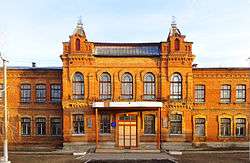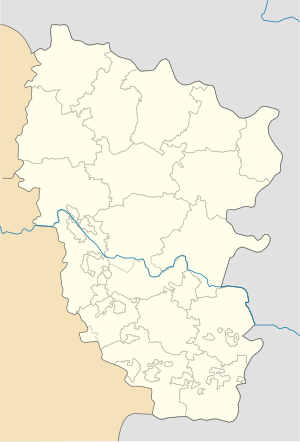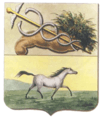Starobilsk
| Starobilsk (Старобільськ) Starobelsk (Старобельск) | |||
|---|---|---|---|
| City | |||
 Luhansk National University building in Starobilsk | |||
| |||
 Starobilsk (Старобільськ)  Starobilsk (Старобільськ) | |||
| Coordinates: 49°16′39″N 38°55′27″E / 49.27750°N 38.92417°ECoordinates: 49°16′39″N 38°55′27″E / 49.27750°N 38.92417°E | |||
| Country |
| ||
| Oblast |
| ||
| Raion | Starobilsk Raion | ||
| First mentioned | 1686 | ||
| City Status | 1938 | ||
| Population (2013) | |||
| • Total | 18,297 | ||
| Area code(s) | (+380) | ||
| Vehicle registration | BB / 13 | ||
| Climate | Dfb | ||
Starobilsk (Ukrainian: Старобільськ, Starobelsk Russian: Старобельск) is a city near Luhansk in Luhansk Oblast, Ukraine. It serves as the administrative center of Starobilsk Raion. The settlement has been known since 1686. The city status was given in 1938. Its population is 17,198 (2017 est.)[1].
History
Starobilsk traces its heritage to the settlement of Belska Sloboda which belonged to Muscovite Voivode and Okolnichy Bogdan Belsky. Belsky arrived to banks of Siversky Donets to built a fortress at southern borders Tsare-Borisov (after Muscovite Tsar Boris Godunov) which was erected not far away in 1598-1600. In 1602 Godunov became suspicious of Belsky and order him to be arrested, stripped of any estates and exiled to Siberia. After the death of Godunov Belsky was granted amnesty in 1605 due to the fact that his sister being a wife of past away Boris Godunov, Maria Skuratova-Belskaya, became a regent. Belsky was sent as a voivode to Kazan where in 1611 was killed by mob after refusing to pledge allegiance to False Dmitriy (False Dmitry II). Sloboda gradually became abandoned, while the fortress was destroyed in 1612 in one of Tatar raids.
In 1686 the settlement was repopulated by servicemen of the Ostrohozk Sloboda Cossack Regiment who originally came from Poltava and Chernihiv regions (from a town of Bilsk in Cossack Hetmanate). Being a runaway serfs, Tsarist government allowed them to settle in military frontier with the Crimean realm to carry out border guard functions. After the place became also populated with serfs from the central regions of the today's Russia, the Tsarist government took measures to find and return those fugitives. In 1701 the Ambassadorial Prikaz decided to conduct a population census in new settlements along Aidar and Siversky Donets. Most population avoided the census. According to data of stolnik M.Pushkin who in 1703 conducted population census in 34 settlements, in Belsky was registered only 41 resident although in reality there were much more.
Trying to meet the demands of Russian landlords who repeatedly turned to the Tsar with complaints and requests to return fugitives, on 6 July 1707 Peter the Great issued an edict (ukase) about the search of "newly arrived from Rus all ranks of people". To the Don was sent a punitive detachment under command of colonel Prince Yuriy Dolgorukiy.[lower-alpha 1] He was charged to search for fugitives and "take them to those landowner from whom they ran away". That action led to the well known Bulavin Rebellion. Struggling with the rebellion, Tsarist troops eventually burnt the settlement to the ground.
In 1732 the settlement was repopulated again by peasants from around Ostrogozhsk (Ostrohozk) turning it into a sloboda Stara-Bila. Among the first of its new residents were again servicemen of the Ostrohozk Regiment led by sotnik I.Senelnykov. In 1782 Staro-Bila was assigned to the Derkul Horse Factory of Bilovodsk district (Voronezh Governorate). On Tsarist edict (ukase) from 1 May 1797 sloboda Staro-Bila was renamed into Starobilsk and became a county city within the Sloboda Ukraine Governorate.
During World War II, it was the site of a Soviet prison camp for Polish prisoners of war (POWs), especially officers. 48 of them died in the camp and were buried in Chmirov cemetery. A large number of the prisoners from the camp were killed during the Katyn massacre in the Kharkiv NKVD building, later buried in Pyatykhatky forest.
During the current War in Donbass many places in Luhansk Oblast were taken over by pro-Russian separatists; however Starobilsk remained under Ukrainian control.[2]
Gallery
 Starobilsk in 1911
Starobilsk in 1911 Starobilsk dam on Aidar River
Starobilsk dam on Aidar River- Starobilsk Monastery
 Year 1910
Year 1910 Soviet city's emblem
Soviet city's emblem Original coat of arms
Original coat of arms
International relations
Twin towns – Sister cities
Starobilsk is twinned with:
Notable residents
- Nadiya Svitlychna, attended a school in the city
Notes
- ↑ not to be confused with the Great Prince of Kiev
References
- ↑ "Чисельність наявного населення України (Actual population of Ukraine)" (in Ukrainian). State Statistics Service of Ukraine. Retrieved 26 August 2017.
- ↑ Aidar soldiers uneasy about future as orders come to leave base, Kyiv Post (9 July 2015)
Ukraine: Risking lives to restore power in front-line villages, ICRC (29 May 2015) - ↑ "Miasta Partnerskie Lublina" [Lublin - Partnership Cities]. Urząd Miasta Lublin[City of Lublin] (in Polish). Archived from the original on 2013-01-16. Retrieved 2013-08-07. External link in
|work=(help)
External links
| Wikimedia Commons has media related to Starobilsk. |
- Website
- Butkov, V., Voitenko, O., Semenov, V., Kholdobin, I. Starobilsk. The history of cities and villages of the Ukrainian SSR.

